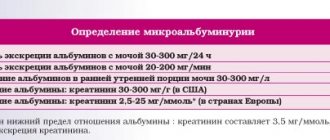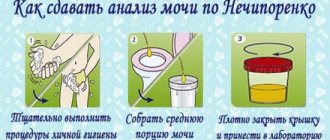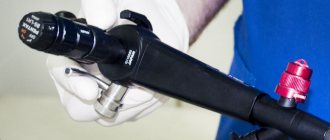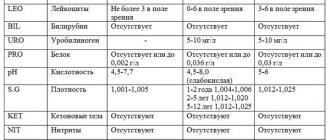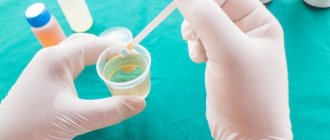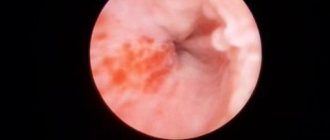Sometimes, when abnormalities are detected in a general clinical urine test or the Nechiporenko test, the patient is prescribed a three-glass test. The purpose of performing this test is to clarify the location and nature of damage to the urinary organs, as well as to facilitate the differential diagnosis of renal and extrarenal pathologies.
The three-glass test is an auxiliary diagnostic method; its essence is to alternately collect urine in three different containers during one act of urination.
What is the three-glass test used for?
As mentioned above, the three-glass test is not an independent diagnostic method, but is used as a supplement to a general urine test or Nechiporenko’s test.
With correct and strictly regular collection of material, the sample helps the doctor to guess the level of localization of the pathological process in the urinary organs (urethra, kidneys or bladder).
Today, a three-glass urine sample is practically not used, which is associated with the advent of more informative diagnostic techniques, such as ultrasound, cystoscopy, cystography, urography, computer diagnostics, etc.
One of the significant disadvantages of the sample is its low information content, especially if the material for research is collected incorrectly.
The classic three-glass test is usually performed in men, when the entire portion of morning urine is collected alternately into three containers in a set ratio. The volume of the second portion should prevail (½ of the total collected material), while the first and third portions constitute ¼ of the volume each.
In women, due to the anatomy and topography of the urinary system, a three-glass sample is usually modified into a two-glass sample (urine is collected in only two containers).
Examinations to clarify the diagnosis
Note that it is incorrect to make a diagnosis based on analysis alone, and it is necessary to undergo a comprehensive examination.
If a bladder tumor is suspected, the diagnosis is confirmed by cystoscopy with biopsy, and the extent of the tumor is clarified using magnetic resonance imaging.
The urethra is examined using urethroscopy if there is a suspicion of a pathological process in the urethra.
A tumor in the bladder can be suspected after an ultrasound examination and characteristic complaints.
To diagnose inflammation in the prostate, the result of a urine test is clearly not enough, even if leukocyturia is present . Moreover, many patients do not have any pathological changes in their urine, so a microscopic analysis of the prostate secretion is performed and a smear from the urethra is evaluated. Additionally, a modern research method is used - PCR - diagnostics for STIs. The accuracy of the method reaches 100%.
On the sonogram (ultrasound picture) you can see the size, structure of the prostate, contours, the presence of tumors, calcifications, and the amount of residual urine.
With cystitis, ultrasound often visualizes thickening of the walls and suspension in the lumen.
The inflammatory process in the kidneys on ultrasound looks like an expansion of the internal cavities; with hydronephrosis, their deformation is more significant.
Tumors, stones, and developmental anomalies require further examination; excretory urography is performed, which makes it possible to judge the urinary tract as a whole and the functional capacity of each kidney.
There are also more in-depth diagnostic methods in urology, so although a three-glass urine sample occupies its niche in the diagnostic search, it would be more reasonable to rely on a modern clinical and urological examination, which is quite accessible.
Victoria Mishina, urologist, medical columnist
17, total, today
( 78 votes, average: 4.51 out of 5)
Scintigraphy: what is it, preparation for the procedure, indications
X-ray of the intestine: what it shows, indications, contraindications, methodology
Related Posts
Who is the test prescribed for?
The test is prescribed by a doctor if a pathology of the urinary system is suspected. So, a test can be prescribed when:
- 1Detection of leukocyturia, hematuria, bacteriuria or abnormalities in the number of epithelial cells in the field of view in a general urine analysis.
- 2 Suspicion of prostate pathology, as a method of additional diagnostics.
- 3The patient has symptoms of urethritis, cystitis, nephritis.
- 4 Presence of pathological (purulent, serous, bloody) discharge from the urethra.
- 5 Frequent urination at night.
- 6 Increased frequency of daytime urination.
- 7 Recurrent pain in the lumbar region.
- 8The presence of pathological impurities in the urine.
Preparing for the study
Long-term preliminary preparation of the patient for taking a three-glass sample is not required. All necessary preliminary procedures are carried out in the morning on the day of collecting the material and submitting the analysis.
It is necessary to prepare in advance three clean sterile containers, which should be numbered according to their serial numbers (1, 2 and 3). The numbering on containers must be clear and understandable, which will prevent them from being mixed up during transportation.
It is not recommended to use previously used containers; this may reduce the diagnostic value of the study. It is best to purchase containers specially designed for this at the nearest pharmacy chain.
Figure 1 - Sterile urine collection container
If it is not possible to buy ready-made sterile containers, then you can use containers with an extended neck. Urine is collected immediately into a jar, which will subsequently be delivered to the laboratory, without subsequent transfusions.
Before donating urine you must:
- 1Refrain from urinating for 5-6 hours, it is optimal to use the first morning urine.
- 2Hygiene the external genitalia with warm water, without using soap or disinfectants.
- 3Open and place containers for collecting material on a stable surface, according to their serial numbers.
- 4Men, before urinating, need to completely push back the fold of skin and expose the opening of the urethra. For women, spread the labia, preferably covering the vaginal entrance with a tampon. You should not collect urine during menstruation. Even urine collected one or two days before menstruation may not be diagnostically informative.
- 5 Severely immobile or paralyzed patients are washed with warm water from front to back, then wiped dry with a sterile gauze swab, sterile napkin or disposable towel. Wiping is also done from front to back.
- 6If you regularly take medications, you should tell your doctor about this before interpreting the result or ordering a test. Cancellation of medications, even if they have the property of changing the color of urine, should not be carried out. Modern diagnostic devices easily differentiate changes in urine as a result of pathology of the urinary system from changes when taking medications.
- 7If the purpose of prescribing a three-glass test is to diagnose prostate diseases, then before urination you can massage the prostate gland to increase the information content of the analysis.
How to properly collect urine for research?
After all the preparatory procedures have been completed, it is necessary to urinate alternately into each of the three containers in one act of urination. It must be remembered that the second portion should make up a little more than half of the total analysis.
In other words, you should urinate a little in the first jar, then collect the bulk of the urine in the second, and fill the third with the rest of the urine. Women can split their urine into two portions. At the end of collecting the material, a portion of morning urine should be distributed among three containers in an approximate proportion of ¼, ½, ¼.
Under no circumstances should you take medium portions and pour the initial part of urine into the toilet! There is also no need to mix containers with each other or pour urine into three containers from one!
Filled containers should be tightly closed with a lid and delivered to the laboratory as soon as possible along with directions for analysis.
Already in the laboratory, urine is examined, the number of formed elements of urinary sediment is counted using a microscope, pH and density of a specific portion are measured, and the level of bacteriuria is assessed. All of the listed urine parameters are assessed separately for each portion and entered into the referral form.
General information
A three-glass urine sample has a second name - Thompson's test. This is a highly informative laboratory test that is used when examining patients with various pathologies. A special method of collecting biological material allows, based on the results of the study, to determine in which part of the urinary tract there is inflammation or other pathology.
In most cases, morning urine is submitted for analysis. You can also donate daytime urine. In this case, the time interval between the last urination and the collection of biomaterial should be 4-6 hours. In some cases, the test may involve prostate massage.
Rules for collecting biomaterial for a three-glass sample
Urine collection can be performed in the classic three-glass version. If the study is carried out during the diagnosis of chronic prostatitis, a prostate massage is performed during the collection of biomaterial.
To conduct a study using this technique, it is necessary to collect all the urine excreted during one urination. It is collected in three special containers. They are filled one by one. In this case, the middle portion should be the largest. Prostate massage is performed by a urologist. In this case, the first two portions of biomaterial are collected, then a massage is performed, and the last container is filled.
If biomaterial is collected at home, it must be delivered to the laboratory as quickly as possible. It is important not to violate the recommended temperature regime in order to avoid obtaining false results. Detailed recommendations are provided by the attending physician or laboratory employee.
Indications for the study
The test is prescribed for symptoms of inflammation. Its results are also used to diagnose prostate pathologies and urethritis. The decision on the need to perform this study is made by the doctor on an individual basis based on the results of other tests, the clinical picture and other factors. \
Interpretation of results
All containers with biological material are examined separately. Therefore, the analysis results are divided into four blocks: data for each portion and general indicators. The test makes it possible to determine the area of the urinary tract in which leukocytes and red blood cells are localized. They are the ones who signal the presence of problems. The technique makes it possible not only to identify pathology, but also to accurately determine its location.
There is no standard as such for this analysis. The results are analyzed taking into account the medical history and other data. They are used to diagnose inflammatory diseases, urolithiasis, malignant neoplasms and a number of other pathologies. Analysis of the results makes it possible to simultaneously identify several diseases present in the patient.
Storage and transportation
Urine sent for testing is stored for no more than 2 hours; the use of preservatives or freezing is undesirable.
Prolonged standing of urine leads to changes in its physical properties, abundant proliferation of bacteria and destruction of urinary sediment elements (red blood cells, white blood cells). In addition, the longer urine is stored, the higher its pH.
This occurs due to an increase in the concentration of ammonia released by bacteria during metabolism. Bacteria in urine also tend to consume glucose, so the level of glucose in urine may also be low if storage parameters are not followed.
Exposure to sunlight is also important, since, for example, bile pigments are destroyed in the light.
If urine is to be stored for more than 2 hours, the material should be kept in a dark, cool place. It should be remembered that the analysis result in this case may not be accurate.
Interpretation of the three-glass sample
When interpreting the results of a three-glass test, two main indicators of urine are usually assessed: hematuria and leukocyturia.
There are three types of hematuria and/or leukocyturia:
- 1Initial - the presence of leukocytes and/or erythrocytes mainly in the first portion of urine.
- 2Terminal - the presence of leukocytes and/or erythrocytes mainly in the last portion.
- 3Total - pathological disorders are equally expressed in all three portions.
An increase in white blood cells and/or red blood cells in portions may indicate the following conditions:
- 1 Deviations are observed exclusively in the first portion: the pathology is located in the anterior part of the urethra. Most often this occurs with inflammation of the urethra (including specific), its polyps, damage, and wounds.
- 2 Deviations only in the last portion of urine - localization of the pathological process in the bladder, terminal urethra, bladder neck, prostate or seminal vesicles. Among the diseases, the most common are chronic prostatitis, cystitis (including cervical cystitis), and bladder tumors.
- 3The presence of abnormalities in all portions indicates involvement of the kidneys, ureters, and bladder. This situation can be observed with nephritis and nephropathies, pyelonephritis, injuries of the kidneys and ureters, urolithiasis, tumors of the kidneys and bladder, chronic cystitis.
Three-glass urine sample
This is a method of examining urine, with which you can determine the probable localization of the pathological process in the urinary tract. Three-glass sample - analysis of three portions of urine obtained from a single urination; in case of diagnosis of chronic prostatitis - after a prostate massage performed by a urologist. Each portion of urine is examined separately. This allows you to determine the approximate localization of the pathological process in the urinary tract: the first portion is a urine analysis from the lower urinary tract, the second portion is a urine analysis from the upper urinary tract (“renal” urine), the third portion is a urine analysis from the bladder. In the case of preliminary prostate massage, prostate secretions are mixed with the urine.
What biomaterial can be used for research?
Urine is delivered by the patient in 3 plastic containers. On the eve of the study, numbered containers for urine and instructions for collecting material must be obtained in the treatment room.
How to properly prepare for research?
On the eve of the test, do not eat vegetables and fruits (beets, carrots, citrus fruits, watermelons), red wine, multivitamins, which can change the color of urine; do not take diuretics. Women are not recommended to take a urine test during menstruation.
Urine collection procedure
- For the study, a full portion of urine is collected, which has been in the bladder for at least 4-5 hours; it is preferable to collect morning urine.
- After thoroughly toileting the external genitalia, the patient begins to urinate into the first container, continues into the second and finishes into the third, it is important that the second portion of urine is larger in volume.
- If a 3-glass urine sample is carried out with a massage of the prostate gland, then in this case the patient urinates in the first two vessels, leaving part of the urine in the bladder. After this, the prostate gland is massaged, and the patient fills the 3rd vessel with urine. Before the study, sexual abstinence for 2 days is recommended.
- Delivery to the laboratory within 24 hours at a temperature of +2 - +24C°.
What is the research used for?
- additional diagnosis of the localization of inflammation after a previous general urine test
- diagnosis of urethritis
- diagnosis of cystitis
- detection of inflammatory kidney diseases (pyelonephritis, glomerulonephritis, urolithiasis)
- detection of inflammatory diseases of the prostate gland (prostatitis, prostate adenoma)
What do the results mean?
Changes in the first portion of urine will indicate pathological processes in the urethra (urethritis). Changes in the second portion of urine will indicate pathological processes in the kidneys, ureters and bladder (cystitis, pyelonephritis, urolithiasis, glomerulonephritis, tumors and injuries of the kidneys and bladder). Changes in the third portion will indicate pathology of the bladder neck and prostate in men (benign prostatic hyperplasia, bladder neck polyp, cervical cystitis, prostatitis, tumors). Detection of changes in all 3 portions will indicate a pathological process in the kidneys or ureters.
Important Notes
The test results must be interpreted by the attending physician, taking into account all anamnestic, clinical and other laboratory data.
Reasons for false results
The reliability of a three-glass sample directly depends on proper preparation for the study and compliance with all stages of collecting material.
Compared to a conventional urine test, this test is difficult for the patient to understand. Even a detailed explanation of the essence of the study does not always lead to compliance with all recommendations for urine collection, which makes the reliability of the analysis and its diagnostic value extremely low.
Main reasons for false results:
- 1Insufficient preparation.
- 2Lack of container labeling.
- 3 Mix-up of samples during storage and transportation.
- 4 Mixing different portions together.
- 5 Pouring urine into three portions from one common container.
- 6 Violation of storage and transportation rules.
If typical deviations in the results of a three-glass sample are identified, additional, more accurate studies are recommended.
What is a three-glass urine test?
A three-glass test is a special method for studying the composition of urine, which is used as an additional study and helps to determine in which part the inflammatory process has developed. To carry it out, urine is collected in a special way, and then it is sent to the laboratory for microscopic examination, the results of which show the level of deviation of leukocytes in the urine from the norm.
This test is used not only to clarify the location of the disease, but also the nature of the damage to the urinary organs; it is also applicable in the differential diagnosis of renal and extrarenal pathologies.
The essence of the three-glass test is to alternately collect urine in three different containers during one act of urination.
However, for the method to make it possible to obtain real data, the collection of material must be carried out strictly according to the rules. Only then can the development of a pathological process in one or another urinary organ be determined, for example, in the urethra, ureters, kidneys, bladder, etc.
As a rule, this additional diagnostic method is applicable when examining men; it also makes it possible to identify disturbances in the functioning of the prostate gland.
As for studies of the female body, women are prescribed a two-glass Thomson test, this is due to the anatomical features of the female body.
Due to the fact that medical science does not stand still and is constantly developing, today a three-glass urine sample is used extremely rarely, since more informative research methods have appeared in the arsenal of doctors:
- ultrasonic;
- cystoscopy;
- cystography;
- urography;
- computer diagnostics and others.
It should also be noted that the three-glass test does have its advantages, these are, first of all, the availability of the method, its low cost, ease of execution, it is simply irreplaceable in cases where it is not possible to use other, more accurate diagnostic procedures.
The disadvantages of the sample include its low informativeness if there are no changes in the urine during a general analysis, the need for additional research, as well as the unreliability of data in cases of incorrect collection of biological material (for the sample to be informative, it is important to strictly adhere to all the details of urine collection and storage , as well as preparation before analysis).
